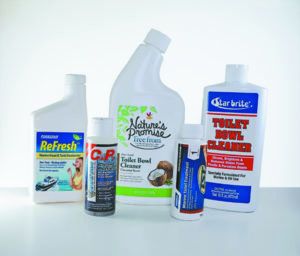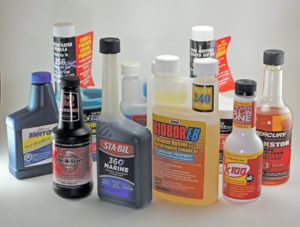
Several of the tests we carried out over the past year were aimed at smaller boat owners who either by choice or budget are bound to the keep it simple sailor (KISS) philosophy.
Star-brite Toilet bowl cleaner
The majority of grocery store toilet bowl cleaners contain bactericides that inhibit bacterial activity in the holding tank and contribute to bad smells. These same chemicals attack the head pump and hose materials, shortening their lives and increasing permeation. There are a handful of eco-friendly and septic-friendly products that work, but you’ll need to read the MSDS sheets and check them against out list of damaging ingredients to be certain.
We strongly urge cleaning in moderation. Anything that contains enough surfactant to make a real difference will logically also strip grease from the head pump. A better strategy is to spray the bowl regularly with a dilution of either one of the suggested head treatments or Raritan CP. Apply elbow grease when needed, and a little CLR for stubborn lime deposits.
In this way the cleaning action is concentrated only where it is needed. When you do need a cleaner, avoid bleach, quaternary amines, and solvents, and use one of our recommended products in moderation. A prolonged soak in a mild acid (CLR, Sew Clean, or other PS tested descaler) to remove calcium deposits from the joker valve and hose is okay, but otherwise avoid long soaks
Although there are many similar products, Star brite Toilet Bowl Cleaner with citric acid and surfactants stood out in our comparison of “green” cleaners.
Bottom line: Toilet cleaning products can be overkill. Star-brite cleaner is both ecofriendly and effective.

Biobor EB For corrosion
Ever since we adopted improved fuel management methods, we’ve enjoyed a decade of no carburetor maintenance—not on the twin 9.9 hp engines that ran our catamaran, not on the dinghy kicker, and not on our trimaran. Not on any of our chainsaw or blower motors. Given the quarterly ritual we’d enjoyed before, it’s been wonderful.
After our initial studies of corrosion in August and December of 2012, we’ve kept an eagle eye on gasoline and diesel additives, researching and testing their effectiveness on reducing corrosion and gumming. Why the fanatical focus on corrosion? Because all of our research and all of our testing (see PS November 2015) suggest that the primary cause of gasoline instability, including gum formation, is metal ions resulting from corrosion of metals. We have also seen that corrosion products are the most common cause of clogging, and that these deposits are harder to remove because solvent carb cleaners can’t dissolve them.
New products have entered the market and old products have been reformulated. Frankly, we expected that all of them were going to wow us this time, with astounding ability to protect fuel systems. But alas, that was not to be.
BioborEB from longtime fuel additive contender Hammonds Chemical was a favorite in our 2012 testing. It once again it provided superior corrosion protection. The treated sample compared with the no-water control. Don’t confuse with Biobor JF, which is a diesel biocide.
Bottom line: This our Best Choice and is what we have been using for the last 10 years.






























